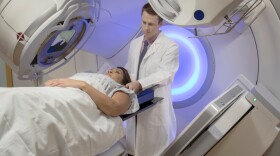The Tarrant County Health Department is keeping an eye on a recent, small outbreak of mumps at Texas Christian University in Fort Worth.
Mumps is a virus often spread by close person-to-person contact. It has flu-like symptoms, but swollen salivary glands are the most recognizable.
The two-dose MMR vaccine against mumps, measles and rubella has kept the virus largely at bay, but recent years have seen multiple outbreaks of mumps — quite often on college campuses.
TCU has seen five cases, but given the long incubation period of the virus and the number of campus activities involving large numbers of people in close contact, more cases are expected.
Interview Highlights
Outbreak at TCU: "There was a case that started in August. We believe they were out of town and in another state at the time of their exposure. [They] came into town and developed symptoms while at TCU and that’s when they became infectious. Since then, we’ve had four more (cases) for a total of five."
Going forward: "There’s a lot of social activities, so we expect more cases. We’ve implemented another vaccine clinic. We use some of what we call 'outbreak vaccine' from the state that we get free of charge. So the idea is to dampen it down."
About the MMR vaccine: "If you’re exposed to a case, we’d recommend an additional dose. But if you’re currently incubating, this particular immunization won’t stop you from getting sick. If you don’t get sick, and then you’re exposed again, because of that boost, you won’t get sick at that point."
Why mumps outbreaks occur on college campuses: "One, the MMR Vaccine has an effectiveness rate of 88 percent. So you have about 12 percent for whom it’s not effective. On college campuses, those people who are susceptible are going to be in lot more contact with others."
Another reason: "With the mumps component of that vaccine, our immunity tends to wane over time. It’s not uniform on everybody, even though they’ve had two vaccines back when they were 5 years old. So, over time, it’s not as effective in those people and, in that sense, you have more susceptibles. Right about the time when they become susceptible, 13 or 14 years after getting that shot, and then we see it in colleges and universities."
Resources





